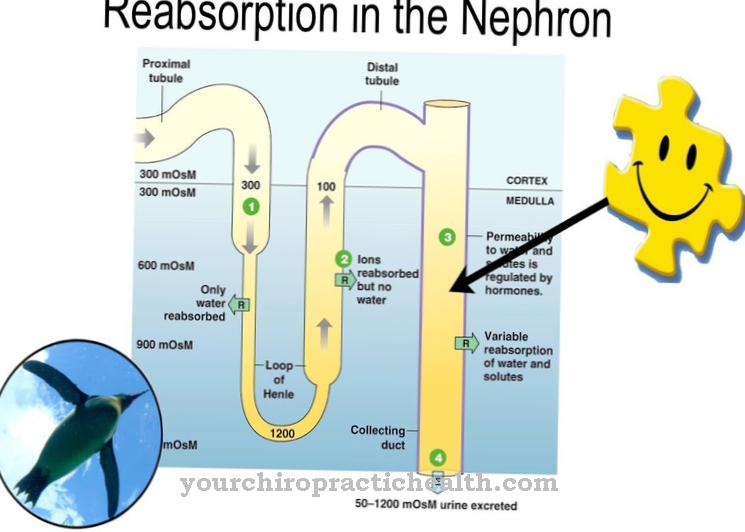Many top athletic performances are exceptional Balance ability embossed. On the other hand, disturbances can significantly impair the quality of life.
What is the balance ability?

The ability to keep the body in a state of equilibrium or to bring it back there after a change is called the ability to balance. It is assigned to the coordinative properties.
The sense of balance in the ear and the responsible centers in the cerebellum, together with the other information systems, are the basic prerequisites for good balance. In addition, however, the individual motor skills and the level of training also determine whether someone is able to successfully carry out balance reactions.
There are 3 types of balance ability. The static describes the ability to maintain a relative rest position for a while. A total resting position is not possible in postures such as standing, standing on one leg or kneeling. Small corrective movements are always necessary. The dynamic ability to balance is characterized by the fact that a stable equilibrium can be maintained during a change in position or can be resumed afterwards. The ability to balance an object with the body is called the object-related ability to balance. The general body reactions that are necessary to maintain balance in normal everyday activities are completely automated and unconscious.
Function & task
The ability to balance is more or less required for all movements and static requirements. Maintaining a state of equilibrium must be defended against forces acting in order to make the execution of motion sequences and the taking and stabilization of positions target-oriented and as economical as possible and to minimize the risk of injury.
In normal activities of everyday life, above all, the gravity and inertia of the body must be overcome. This can be illustrated well using the example of walking, but basically applies to all movement processes. During normal gait, the trunk is stabilized in the upright position with only little deviation to the side, while the legs are moved in a coordinated manner with the most economical movement amplitudes possible. The projection of the body's center of gravity always stays in the area of the support area. The gait is safe and can be carried out for a long time without great effort if the motor properties are appropriately available.
Changes in the properties of the environment can significantly increase the balance requirements. Uneven, shaky surfaces in various forms of terrain or walking or climbing on narrow paths demand significantly more motor skills and the result is that the control is no longer fully automated, and awareness is then switched on. Professional groups such as roofers are particularly exposed to such balance requirements.
In sporting activities, especially with top athletes, the ability to balance is often a decisive factor that decides whether it is successful or not. The corresponding motor properties must be trained again and again in connection with the required movement sequences in sport-specific situations. Often it is fast turning movements such as somersaults, handstand rollover or pirouettes, extreme stabilization requirements such as handstand or a combination of both requirements that demand the ability to balance to the highest degree.
For such top performance, appropriate skills in the areas of strength, speed, speed and coordination are required. In addition, communication with the neural control systems must function optimally and be trained. For this it is not enough to simply stupidly practice the sequences of movements that are required. Particularly for the optimization of the nerve-muscle interaction, it is important to continually incorporate new requirements and stimuli for the various sensory systems into training and to create variations that improve cognitive performance and pave the way for neural action.
You can find your medication here
➔ Medicines for balance disorders and dizzinessIllnesses & ailments
All diseases that affect either the motor properties or the capacities of the sensory systems involved and the control center in the cerebellum can impair the ability to balance. In the orthopedic-surgical field, this includes all degenerative diseases and ailments that are associated with long-term pain problems.
In these cases, the gentle posture and the gentle behavior lead to a loss of strength and experience of movement. Initially, such deficits become noticeable when there are high demands on the ability to balance, but later also in the case of simple stresses such as walking or standing. One-legged standing or one-legged hopping are typical forms of stress in which this loss of function becomes apparent.
All types of dizziness have an immediate effect on balance. The sensory information provides the affected people with a changed picture of their perception of their surroundings, and it is often no longer possible to control balance reactions. A common form of vertigo is paroxysmal positional vertigo, in which deposits in the endolymph of the organ of equilibrium in the ear lead to irritation when changing position.
Neurological diseases can affect the motor system or the control system or both and lead to a significant impairment of the ability to balance. Polyneuropathies cause flaccid paralysis of the foot muscles, often associated with impaired sensitivity. Compensatory movements while walking and standing can then not or only insufficiently take place, equilibrium reactions via the control of the foot muscles fail. The walk becomes increasingly unsafe and at some point is only possible with aids.
Diseases of the cerebellum such as ataxia or a brain tumor have a significant influence on the control of the muscles that are responsible for maintaining balance. The consequences are similar to those of polyneuropathy, but much more serious. The same goes for multiple sclerosis and other neurological diseases.
The ability to balance fundamentally decreases with age, as on the one hand the muscular abilities decrease and on the other hand the brain performance and the impulse rates of the nerve-muscle system decrease. However, this statement can be put into perspective, since the performance is in direct relation to the training state. Motor skills can also be trained in old age, especially strength. The earlier the systematic training is started, the lower the risk of losing performance and quality of life in old age.













.jpg)

.jpg)
.jpg)











.jpg)